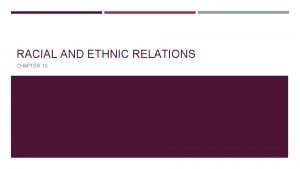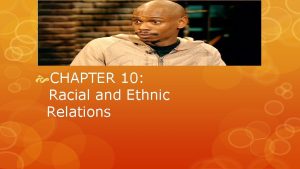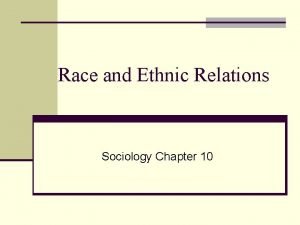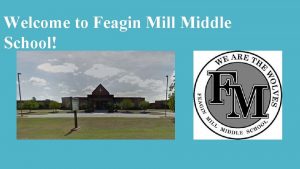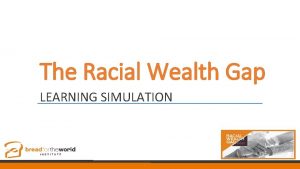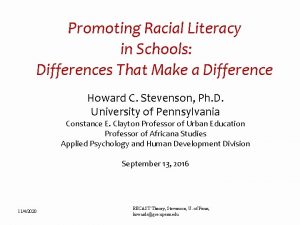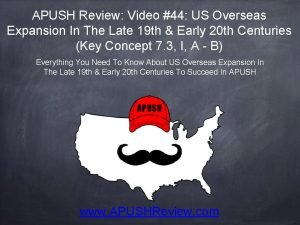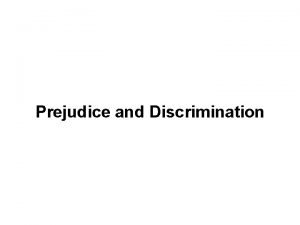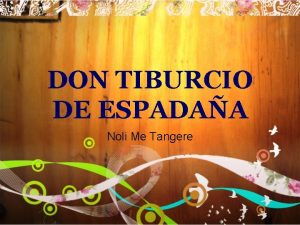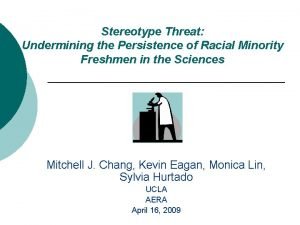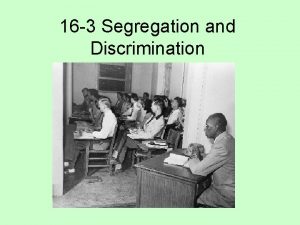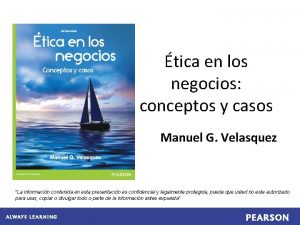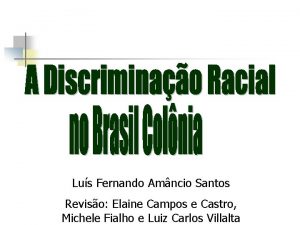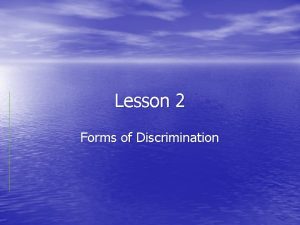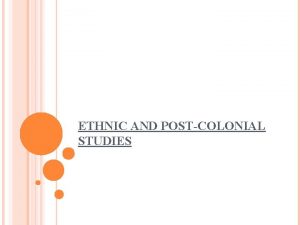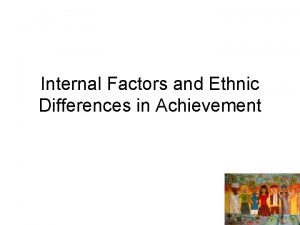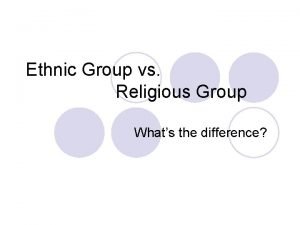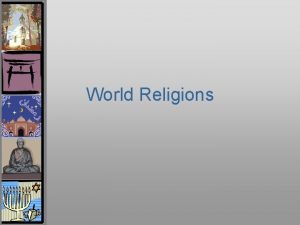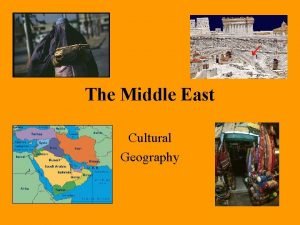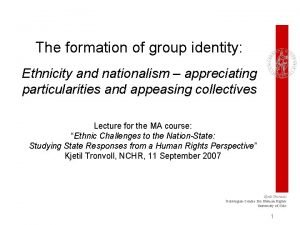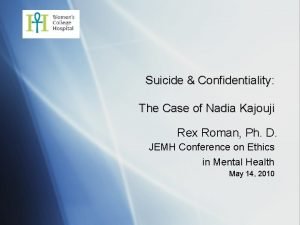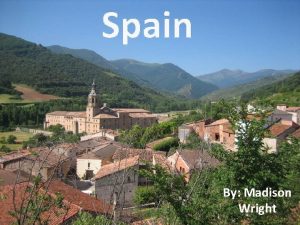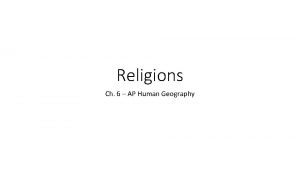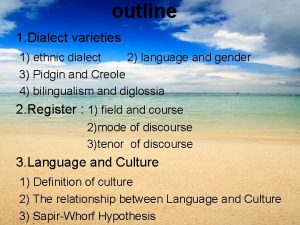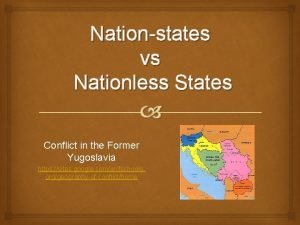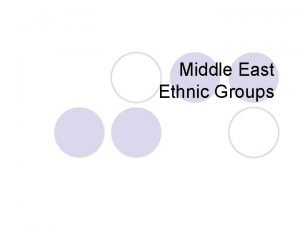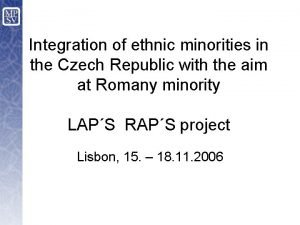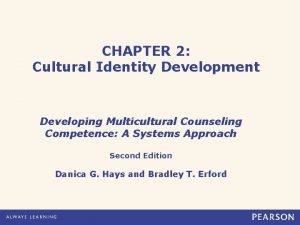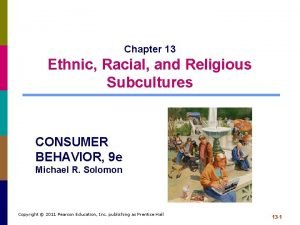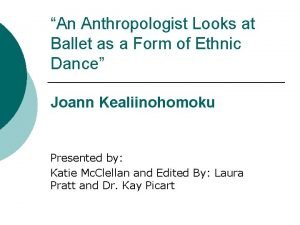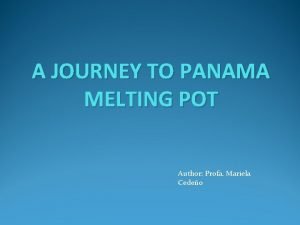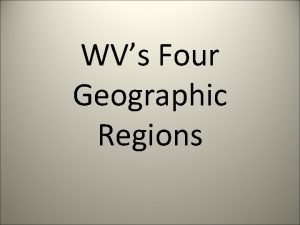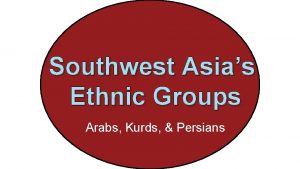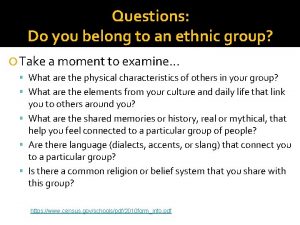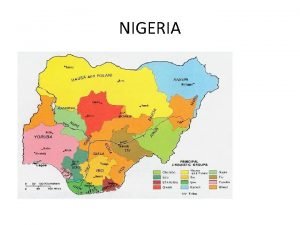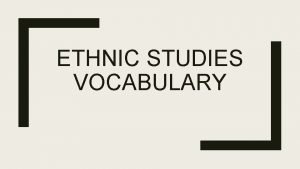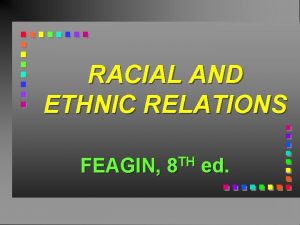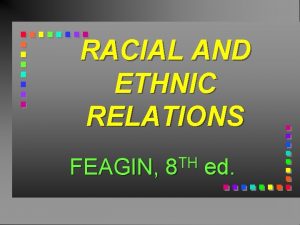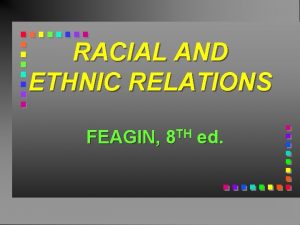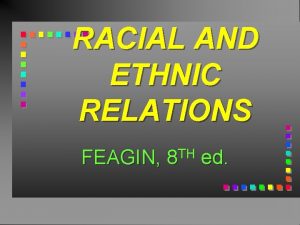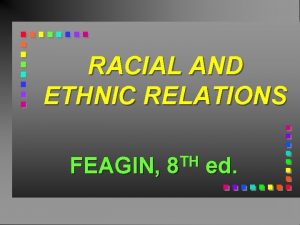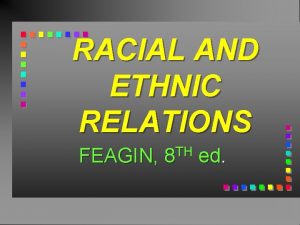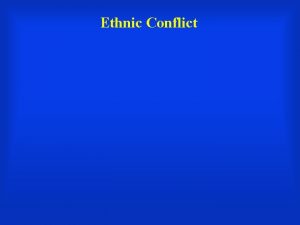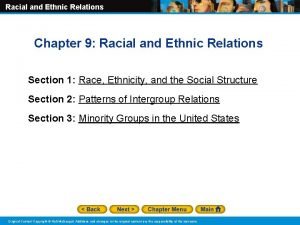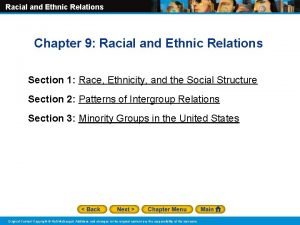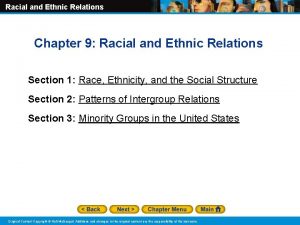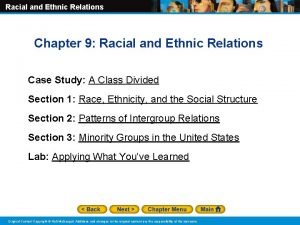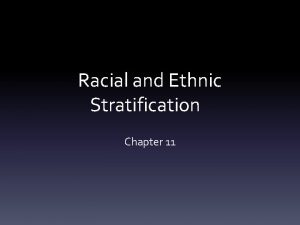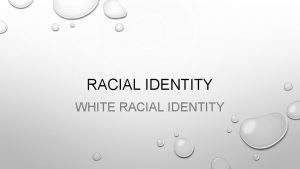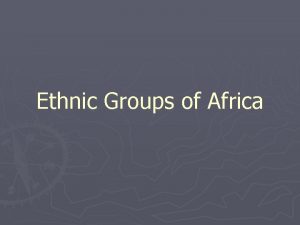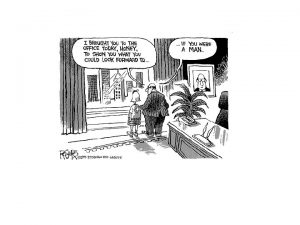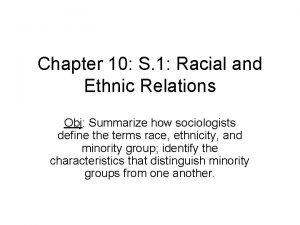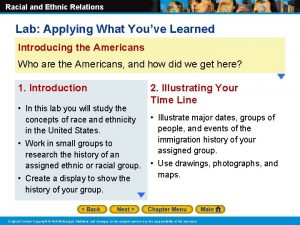RACIAL AND ETHNIC RELATIONS FEAGIN TH 8 ed













































- Slides: 45

RACIAL AND ETHNIC RELATIONS FEAGIN, TH 8 ed.

PUERTO RICAN AND CUBAN AMERICANS CHAPTER 9

• Puerto Rico and Cuba • • • Spanish-speaking islands in the Antilles Point of origin for large numbers of Latinos Puerto Rico • • • San Juan is oldest city under U. S. flag All Puerto Ricans are U. S. citizens but Puerto Rico not a state Island’s future debated by 3 groups • • Independence, statehood , and commonwealth Cuba • Oscillation between corrupt democracy and dictatorship

• PUERTO RICANS Borinquén • • Original name for Puerto Rico Indigenous population in 1493 when Spanish imperialists arrived • • Used as forced labor in mines Genocidal decline • • • Forced labor, disease, brutal killings, violent suppression of rebellion Enslaved Africans imported Proportion of whites and people of color almost equal • People product of several racial and ethnic heritages

FROM SPANISH TO U. S. RULE • • 1897, Puerto Ricans pressured Spanish into granting autonomy 1899 Spanish-American War Treaty • • • Spain gave Puerto Rico to America 1917 Jones Act awarded U. S. citizenship to Puerto Ricans 1940 s Operation Bootstrap • • Program designed by Puerto Rican governor to bring economic development by attracting U. S. corporations 1970 s high unemployment encouraged migration to mainland

MIGRATION TO MAINLAND • 1900, about 200 Puerto Ricans lived on mainland mostly in New York • • • 1940 --numbered almost 70, 000 Over next two decades increased to 887, 000 Since 1970 involved in return or circular migration • • Fled island’s poverty and economic crises and encountered problems of unemployment and poverty on the mainland Mid-2000 s--half of all Puerto Ricans resided in mainland communities making them 1/10 th of all Latinos

Joined by Other Latinos: Diversity in the New York Area • • 1990 s--city Anglo population decreased to less than half city’s population Early 2000 s--Latino population of Long Island increased to 282, 693 • • • Puerto Rican-27%, Mexican or Cuban-8%, rest are Caribbean or Central or South American origin Increasingly Salvadoran, Colombians, and Dominicans Latino diversity has encouraged pan. Hispanic identity

PREJUDICES AND STEREOTYPES • Puerto Ricans long suffered racial stereotypes similar to Mexicans • • Lazy, submissive, emotional Often referred to derogatorily as spics and viewed as criminals Stereotype of criminals and drug users influence police actions in Puerto Rican communities Underrepresented on television programs • Esai Morales co-founder of Washington’s National Hispanic Foundation for the Arts

• Other Negative Images Culture of Poverty – anthropologist Oscar Lewis • • Stereotyped idea that poor people often develop a defective and deviant subculture Frequently, whites emphasize accents of Latinos as problematic when they do not do the same for those with other types of accents Image of lazy Puerto Ricans on welfare still found at high levels of government Whites couple negative images of Latinos with fearful views of immigrants

• • Color Coding and White Prejudice and stereotypes motivate discrimination against Puerto Ricans and have a negative effect on their lives Puerto Rico, like other Latino countries • • • Recognize a spectrum of racial categories based on multiple physical and cultural characteristics Puerto Rican society more integrated than mainland society Color Coding • Social stratification or discrimination based on skin color

ECONOMIC AND RELATED CONDITIONS: THE MAINLAND • Discrimination common for Puerto Rican immigrants • • Puerto Ricans brought many talents and skills • • • Those with darker skin suffered the most Yet, skills went unused on the mainland Unemployment much higher for mainland Puerto Ricans than for white workers Mainland Puerto Rican communities have distinctive social classes


• • Employment Discrimination Institutionalized discrimination long rooted in color coding and linguistic prejudice Underrepresented relative to their population percentage in New York City • • Institutionalized discrimination seen in height and weight requirements that disqualify Puerto Rican applicants Employment opportunities heavily shaped by discrimination • White job applicants with felony records as likely to be called back as Puerto Ricans with no felony records

• Industrial Restructuring Variety of changing structural factors in the economy have contributed to high unemployment • • New York City moved from industrial to serviceoriented economy Presence of employed workers is crucial to a community’s survival • Unemployed Puerto Ricans resided next to employed blue-collar workers who help them and maintain the community’s social institutions • Mainland Puerto Ricans relatively poor compared to other U. S. groups

• Housing Problems Housing discrimination a significant problem for Puerto Ricans • • • Compared with other major groups Puerto Ricans have been excluded from most housing markets Recently, neighborhoods have experienced gentrification Latinos pressed New York’s attorney general for action against housing discrimination • Darker skin Latinos, again, suffer more discrimination than light skin Latinos

EDUCATION • 2000 Census • • Just over 64% of Puerto Ricans had completed high school compared with 88% of whites High dropout/pushout rates remain a nationwide problem Low college graduation rate for mainland Puerto Ricans restrict socioeconomic mobility Puerto Rican parents struggle against an educational system that has typically failed their children

Barriers to Social and Economic Mobility • Few Puerto Ricans in influential positions in education • • • Puerto Rican communities have little control over educational policies and curriculum decisions Curriculum often based on assumption that Puerto Ricans are culturally or linguistically deficient Public schools are de facto segregated • Racially segregated schools have negative implications

Language • • Few schools today structured to deal with non. English speaking students In current atmosphere of hostility to bilingual education, limited English proficiency creates barriers for Latinos • • • Often inaccurately assigned to low-ability groups Puerto Rican students do less than white students on conventional achievement tests Herman La Fontaine -- viable “definition of cultural pluralism” • Concept that language and culture be given equal status to that of the majority population

Official English Policies and Spanish Speakers • Support for English as the official language grown dramatically in recent years • Xenophobic Americans praise English-only policies as a means to unify diverse groups and promote traditional (European) values • • Efforts toward linguistic cohesion resonate with colonial domination that threatens to silence the less powerful Language reflects and imbeds a group’s history and culture and is inseparable from group and personal identity

POLITICS • In Puerto Rico, substantial majority of island’s registered voters usually vote on election days • • In mainland, voting rates much lower Increased since 1990, especially in areas where government is responsive to community needs Election to major political office came slowly for mainland Puerto Ricans House representation tripled in 1992 • Still just three in House and none in Senate

• • Local and State Government Recently, Puerto Ricans served on numerous city councils and as mayors of small towns and a few cities Long-term effects of institutional discrimination seen in state and city government • • Many report poor treatment by government and private agencies 1980 s--Puerto Rican governor announced campaign to register mainland voters thus expanding their political power

Politics and Recent Intergroup Conflict • In New York City, Puerto Ricans and African Americans make up half the population • • Long period of successful coalitions and periodic tensions Puerto Ricans critical to vote of David Dinkins (1989) – 1 st black mayor Al Sharpton assisted in protest of U. S. Navy test bombing of a Puerto Rican island Puerto Rican mayoral candidate, Fernando Ferrer, supported by blacks

• PROTEST In Puerto Rico, protest against colonial status periodically punctuated U. S. rule • • Puerto Ricans fought hard to retain their language and culture Recent Republican and Democratic parties have supported statehood • • Supporters of statehood argue commonwealth status is second-class Opponents fear economic and cultural changes of statehood • • Assimilation is unacceptable to Puerto Ricans 2006 --Panama delegation supported independence

On the Mainland • Arriving poor and stigmatized as inferior, Puerto Ricans developed significant organizations to cope with discrimination and other barriers • • • Puerto Rican Legal Defense and Education Fund National Puerto Rican Coalition Recently, numerous Puerto Rican organizations worked for better quality of life and increased participation in political process • Significant number of social and cultural clubs seek to preserve elements of the culture

• More Community Protest Puerto Rican communities long protested discrimination by local whites • • Some protest movements brought significant changes • • • Latinidad - Idea of Latino cultural unity in struggles against gentrification Founding of community college in the Bronx and supportive programs at CUNY Grass-roots coalitions created to improve economic conditions Puerto Rican Day Parades held since 1950 s

• • • RELIGION Catholicism long been main religion among Puerto Ricans Puerto Rican and Cubans developed distinctive branching religions On mainland, Puerto Rican Catholics led by non-Latino clergy • • Latino caucuses pressed for Spanish-language services and more Latino priests Many left for evangelical Protestant churches • • Warmer reception and community feeling Many communities have numerous storefront evangelical churches

ASSIMILATION OR COLONIALISM • • Over decades Puerto Ricans resisted complete acculturation There is continuing racialization of Puerto Ricans by influential whites Overt job discrimination appears to be declining though covert and subtle discrimination remains Structural assimilation at primary group level and marital assimilation has not reached levels comparable to those of past European immigrants • Generational conflict is a problem

• • Power-Conflict Perspectives Anglo-conformity pressure on Puerto Ricans has been heavy Assimilation into economic and political mainstream relatively slow Analysts of U. S. treatment of Puerto Ricans generally concerned more about negative effects of racialization, racial discrimination, unemployment, and deteriorating housing areas on socioeconomic futures of Puerto Ricans Internal colonization seen in “urban enterprise zones” created in older cities

CUBAN AMERICANS: PATTERNS OF IMMIGRATION • • 3 RD largest Latino group at nearly 1. 5 million Like Puerto Ricans, group has its roots in an important Caribbean island close to U. S. Most migration stemmed from political upheaval or economic distress on the island Early Cuban exiles lobbied for official U. S. support of Cuba’s liberation from Spain

• • • Cuba became U. S. protectorate in 1902 Political turbulence accompanying successful repressive dictators brought political exiles to U. S. Large numbers migrated to U. S. after 1959 revolution of Fidel Castro who overthrew Fulgencio Batista • • Victory brought hope for economic and political reform Castro’s threat to U. S. businesses, suspicion of communism, and declarations of nontolerance led to break in diplomatic relations with U. S.

• • • 1 st major immigration after revolution was Cuba’s monied elite 2 nd wave began in 1961 --middle and upper -income who chose exile rather than life under Castro Early groups composed of lighter-skinned Cubans and Florida was usual destination Immigrants and U. S. viewed Cubans as refugees who intended to return when Castro was overthrown 3 rd group arrived between 1965 and 1970 s

• The Mariel Immigrants Mariel Boatlift • • 4 th group of 125, 000 Cubans who came to U. S. in 1980 Popular stereotypes characterized them as undesirables • • Less education and containing large percentage of criminals and mentally ill Some left voluntarily; others, considered undesirable by Cuban government, forced to leave Unlike earlier immigrants, approximately 40% were darker skinned Nearly 1. 5 million Cubans live in U. S.

INTERGROUP CONFLICT • Major result of Cuban migrations is significant change in population of Florida • • Tension accelerated between Cubans and black residents • • • By 1980 s, Latinos majority in Miami Blacks felt Cubans getting too much government assistance Recently, Cuban American leaders angered black community when they ignored visiting black officials Tension again surfaced in 2000 and 2004 elections

Racial Division Among Cuban Americans • Cuban American population diverse in terms of racial gradient central to U. S. society • Before revolution, Cuban society segregated • • • Lighter-skinned Cubans had more residential and economic privileges than darker-skinned Castro decreed equality between the two In U. S. immigrants faced a world in which societal privileges were linked to racial classification

STEROTYPES AND DISCRIMINATION • • Cuban Americans sometimes stereotyped as anti-Castro militants or extremists Some analysts stereotyped Cuban Americans as predominantly successful or affluent group that does not face racial discrimination • Susan Eckstein • • Anglo upper class, professional, and business community excluded Cubans from informal social circles and interest groups Like other Latinos, Cubans experienced discrimination at hands of Anglo whites

THE ECONOMIC SITUATION • • Cuban immigrants experienced dramatic decline in occupational status when they entered U. S. economy Increased Cuban presence in Florida elevated Miami’s importance as center for Latin American commerce Compared with other Latino groups, Cubans enjoy greater economic success Motivated by concern to “fight Communisim, ” U. S. government assistance provided to Cubans was unprecedented

• Wide range of occupations among Cubans facilitated development of large and interdependent local economy • • Another factor of mobility is economic organization of the Cuban family • • Appeals to group solidarity helped some business people exploit their compatriots as low -wage workers Gainful employment of women became economic necessity for upward mobility in U. S. Among Latino groups, Cubans have relatively high levels of economic success

POLITICS • • Expectation of short-lived Castro regime led most Cubans to remain politically inactive in U. S. , though they sought to influence U. S. policy toward Cuba Since 1980 s Cubans have become more politically active • • • 2/3 rds of adults are citizens and they register to vote in large numbers Many remain involved in politics of Cuban American National Foundation • Influential group established in 1981

• Cuban community currently divided over proper U. S. government response to Cuban government • • In the past, some engaged in paramilitary training and terrorist acts against Castro • • Political division substantially result of different views and experiences of immigrants who came between 1959 -1965 and those who came since 1980 s Exiles recruited by CIA involved in unsuccessful Bay of Pigs invasion of 1961 Collapse of Soviet Union brought severe economic hardships to Cuba’s people

RELIGION • Santería • • A type of syncretic religion that included aspects of both Catholic and older African religions Mid-2000 s survey found Cubans less likely than other major Latino groups to say religion is the most important thing in their lives Less opposed to abortion than Puerto Ricans or Mexicans Pan-Latino diversity leaves some Cuban parishioners feeling alienated because of different approaches to Catholic religion

ASSIMILATION OR COLONIALISM • • Like other Latinos, Cubans faced prejudice and discrimination including language and restriction or exclusion in Anglo-dominated organizations and institutions Identification assimilation came slowly, especially for older Cubans who consider themselves exiles • 1/3 rd of population say they have a double identity

• Identification of Cuban American women and African American women • • African American women felt they were American but not seen as such by Anglo whites Cuban American women did not feel they were American and did not think Anglo whites saw them as American Preservation of Cuban culture and identity provides a foundation for economic and political integration in U. S. society Over time, Cubans made significant economic achievements which linked them to the mainstream economy and politics

• • • Cuban Americans similar to a few other immigrant groups that achieved significant degree of economic prosperity and integration during 1 st generation Cultural assimilation pressures created cross-generational problems similar to earlier European immigrants 1990 s--Strategy Research Corporation • Ranked Cubans least culturally assimilated based on language use and behavioral and attitudinal measures

• • • Cuban Americans especially in south Florida adapted selectively to U. S. Nonetheless, younger generations are assimilating more rapidly than Cubanborn to the dominant culture Dominant Euro-American culture does regularly make some modest adjustments to new groups entering the society • • Latino music, Cuban, Mexican, and other foods Chain retailers have discovered this group’s buying power ($400 billion)

Power-Conflict Perspective • No one has applied a sustained powerconflict perspective to case of Cuban Americans • Opportunities and accomplishments of U. S. born generations (lighter skinned majority) • • Includes growing numbers of businesspeople, professionals, and managers Substantially greater political and civic integration with dominant group can occur only if later generations disperse residentially
 Chapter 10 racial and ethnic relations
Chapter 10 racial and ethnic relations Chapter 10 racial and ethnic relations
Chapter 10 racial and ethnic relations Chapter 10 racial and ethnic relations review worksheet
Chapter 10 racial and ethnic relations review worksheet Feagin mill middle school
Feagin mill middle school Black studies and the racial mountain
Black studies and the racial mountain Employee relations in public relations
Employee relations in public relations Jim crow laws in what region or regions did it exist
Jim crow laws in what region or regions did it exist Racial wealth gap simulation
Racial wealth gap simulation Promoting racial literacy in schools
Promoting racial literacy in schools Racial theories apush
Racial theories apush Racial prejudice
Racial prejudice Symbolism of characters in noli me tangere
Symbolism of characters in noli me tangere Racial insults
Racial insults In what region did racial etiquette exist
In what region did racial etiquette exist Cartel ley organica contra la discriminacion racial
Cartel ley organica contra la discriminacion racial Democracia racial
Democracia racial Lesson 2 racial discrimination
Lesson 2 racial discrimination Ethnicity in postcolonialism
Ethnicity in postcolonialism Ethnocentric curriculum
Ethnocentric curriculum Whats an ethnic group
Whats an ethnic group How are ethnic groups and religious groups related
How are ethnic groups and religious groups related Sikhism universalizing or ethnic
Sikhism universalizing or ethnic Ethnic groups in the middle east
Ethnic groups in the middle east Ethnic boundary marker
Ethnic boundary marker Nadia kajouji ethnic background
Nadia kajouji ethnic background Spain ethnic groups
Spain ethnic groups Diffusion of judaism ap human geography
Diffusion of judaism ap human geography Universalizing religion
Universalizing religion Ethnic formation
Ethnic formation Nigga
Nigga Ethnic cleansing kosovo 1998
Ethnic cleansing kosovo 1998 Ethnic groups in the middle east
Ethnic groups in the middle east Ethnic groups cloze notes 1 answer key
Ethnic groups cloze notes 1 answer key Ethnic groups in czech republic
Ethnic groups in czech republic Largest ethnic religion
Largest ethnic religion Feminist identity development model
Feminist identity development model Ethnic subcultures
Ethnic subcultures An anthropologist looks at ballet
An anthropologist looks at ballet Write 5 ethnic groups you know in panama en español
Write 5 ethnic groups you know in panama en español Potomac section geographical features
Potomac section geographical features Southwest asia ethnic groups
Southwest asia ethnic groups Which ethnic group do you belong to
Which ethnic group do you belong to Philippine idiophone instruments
Philippine idiophone instruments 250 ethnic groups in nigeria
250 ethnic groups in nigeria Identity diffusion
Identity diffusion Acculturation
Acculturation
